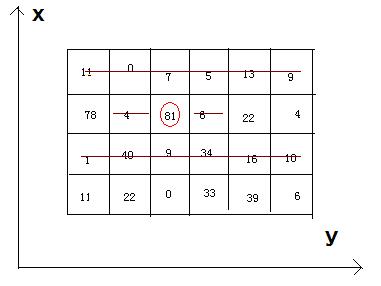Problem Description
Bean-eating is an interesting game, everyone owns an M*N matrix, which is filled with different qualities beans. Meantime, there is only one bean in any 1*1 grid. Now you want to eat the beans and collect the qualities, but everyone must obey by the following
rules: if you eat the bean at the coordinate(x, y), you can’t eat the beans anyway at the coordinates listed (if exiting): (x, y-1), (x, y+1), and the both rows whose abscissas are x-1 and x+1.

Now, how much qualities can you eat and then get ?

Now, how much qualities can you eat and then get ?
Input
There are a few cases. In each case, there are two integer M (row number) and N (column number). The next M lines each contain N integers, representing the qualities of the beans. We can make sure that the quality of bean isn't beyond 1000, and 1<=M*N<=200000.
Output
For each case, you just output the MAX qualities you can eat and then get.
Sample Input
4 6 11 0 7 5 13 9 78 4 81 6 22 4 1 40 9 34 16 10 11 22 0 33 39 6
Sample Output
242
Source
每行来一次最大非连续子列。完了压缩后最后再来一次=。
=。只是要符合条件啦
#include<iostream>
#include<cstdio>
#include<cstring>
#include<algorithm>
#include<limits.h>
using namespace std;
const int maxn=200020;
int n,m;
int sum[maxn],a[maxn];
int main()
{
int n,m;
while(~scanf("%d%d",&n,&m))
{
for(int i=1;i<=n;i++)
{
for(int j=1;j<=m;j++)
scanf("%d",&a[j]);
for(int j=2;j<=m;j++)
a[j]=max(a[j-2]+a[j],a[j-1]);
sum[i]=a[m];
}
for(int i=2;i<=n;i++)
sum[i]=max(sum[i-2]+sum[i],sum[i-1]);
printf("%d
",sum[n]);
}
return 0;
}
版权声明:本文博主原创文章,博客,未经同意不得转载。